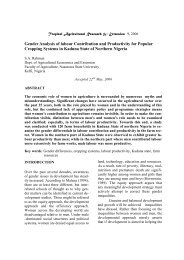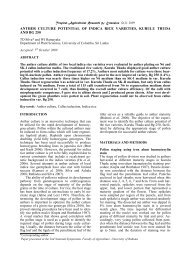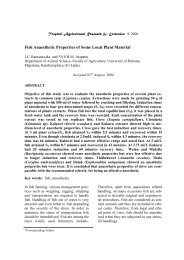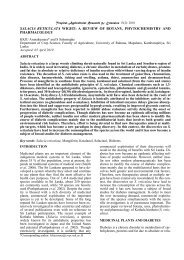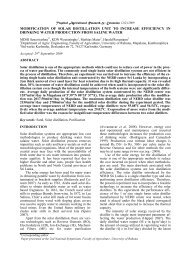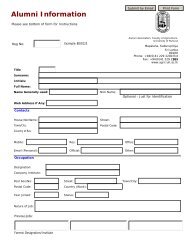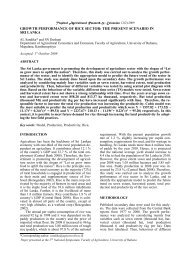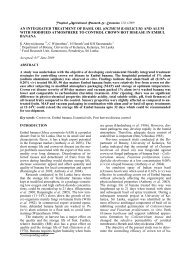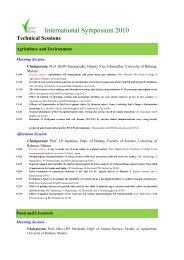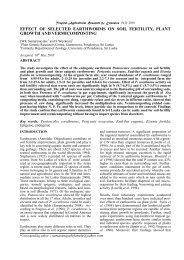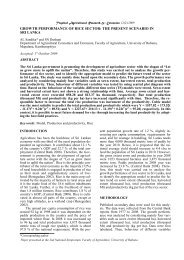efficacy of selected granular insecticides for the control of maize ...
efficacy of selected granular insecticides for the control of maize ...
efficacy of selected granular insecticides for the control of maize ...
You also want an ePaper? Increase the reach of your titles
YUMPU automatically turns print PDFs into web optimized ePapers that Google loves.
Tropical Agricultural Research & Extension 14(1): 2011<br />
EFFICACY OF SELECTED GRANULAR INSECTICIDES FOR THE<br />
CONTROL OF MAIZE-STEM BORER (CHILO PARTELLUS)<br />
(LEPIDOPTERA: PYRALIDAE)<br />
KNC Gunewardena* and SRK Madugalla<br />
Field Crops Research and Development Institute, Maha Illuppallama, Sri Lanka<br />
Accepted: 1 December, 2010<br />
ABSTRACT<br />
Stem borer (Chilo partellus) is <strong>the</strong> most destructive pest <strong>of</strong> <strong>maize</strong> causing considerable yield losses<br />
especially during yala season. At present <strong>the</strong> pest is managed through whorl application <strong>of</strong> insecticide<br />
granules or foliar spraying <strong>of</strong> liquid <strong>for</strong>mulations <strong>of</strong> <strong>insecticides</strong>. However, effective <strong>control</strong> <strong>of</strong> <strong>the</strong> pest<br />
cannot be expected from liquid <strong>for</strong>mulations due to practical difficulties in <strong>the</strong> spraying especially at<br />
<strong>the</strong> mature stages <strong>of</strong> <strong>the</strong> crop. Hence, investigations were carried out in two consecutive yala seasons in<br />
2008 and 2009 to study <strong>the</strong> <strong>efficacy</strong> <strong>of</strong> <strong>granular</strong> type <strong>insecticides</strong> against <strong>the</strong> stem borer. The <strong>maize</strong><br />
hybrid variety Sampath was used. Four <strong>insecticides</strong> were tested along with an untreated <strong>control</strong>.<br />
Insecticides were applied twice as whorl applications at 2 week interval.<br />
The percentage stem borer damage in plots treated with Diazinon 5G, Fipronil 0.3G and Thiocyclam<br />
hydrogen oxalate 0.4G found to be < 8% as compared to > 35% damage in untreated <strong>control</strong>. Larval<br />
population and severity <strong>of</strong> stem borer damage were also significantly low in Diazinon 5G, Fipronil 0.3G<br />
and Thiocyclam hydrogen oxalate 0.4G treated plots during both seasons over <strong>the</strong> <strong>control</strong>. The<br />
percentage seed yield in Diazinon 5G, Fipronil 0.3G and Thiocyclam hydrogen oxalate 0.4G treated<br />
plots found to be 52-91% and 28-44% higher than <strong>the</strong> untreated <strong>control</strong> during yala 2008 and 2009<br />
respectively. There<strong>for</strong>e, Fipronil 0.3G and Thiocyclam hydrogen oxalate 0.4G can be recommended in<br />
addition to <strong>the</strong> present recommendation <strong>of</strong> Diazinon 5G <strong>for</strong> <strong>the</strong> <strong>control</strong> <strong>of</strong> stem borer in <strong>maize</strong>.<br />
Key words: Chilo partellus, Granular, Insecticides, Maize, Stem borer<br />
INTRODUCTION<br />
Maize (Zea mays L) is one <strong>of</strong> <strong>the</strong> most<br />
important cereal crops grown in Sri Lanka. The<br />
area under <strong>maize</strong> in Sri Lanka is about<br />
51,000ha and production is about 112,000t in<br />
2008 (AgStat, 2009). In terms <strong>of</strong> area and<br />
production, it ranks second after rice among<br />
<strong>the</strong> cereal grains (Hindagala, 1980). Maize<br />
stem-borer (Chilo partellus) is considered as<br />
<strong>the</strong> most destructive pest causing losses up to<br />
75%. Infestations at seedling stage may cause a<br />
total failure <strong>of</strong> <strong>the</strong> crop (Khan et al. 1999,<br />
Rahim and Masud 1992, Sekhon and Kanta<br />
1992). This pest also attacks o<strong>the</strong>r grain crops<br />
such as sorghum, millets, sugarcane and rice.<br />
The young stem-borer larvae are small, spotted<br />
and yellowish. When full grown, <strong>the</strong>y are 20 to<br />
25mm long and spotted with coloured stripes<br />
along <strong>the</strong> back <strong>of</strong> <strong>the</strong> body. Pupation takes<br />
place in <strong>the</strong> stem in a small chamber. The straw<br />
colored moth (15mm), deposits white scale like<br />
eggs in overlapping rows, usually on <strong>the</strong><br />
*Corresponding author : nishanthigun@yahoo.com<br />
underside <strong>of</strong> <strong>the</strong> leaves (Alejandro 1987). Stem<br />
-borer starts to infest <strong>the</strong> crop at 3 to 4 weeks<br />
after planting and continue up to maturity stage<br />
(Subasinghe 1988). Larvae which attacks all<br />
parts <strong>of</strong> <strong>the</strong> <strong>maize</strong> plants except roots injure <strong>the</strong><br />
young leaves and later bore into <strong>the</strong> stem,<br />
tassels, stalks and ears <strong>of</strong> <strong>the</strong> <strong>maize</strong> plants<br />
(Khan and Amjad 2000). The present<br />
recommendations <strong>for</strong> <strong>the</strong> management <strong>of</strong> this<br />
pest include foliar spraying <strong>of</strong> Novaluron<br />
10EC, Thiodicarb 375SC, Et<strong>of</strong>enprox 10EC or<br />
application <strong>of</strong> <strong>granular</strong> <strong>for</strong>mulation, Diazinon<br />
5G. However, effective <strong>control</strong> <strong>of</strong> <strong>the</strong> pest<br />
cannot be expected from liquid <strong>for</strong>mulations<br />
due to practical difficulties in application<br />
especially in <strong>the</strong> advance stages <strong>of</strong> <strong>the</strong> crop. On<br />
<strong>the</strong> o<strong>the</strong>r hand, Diazinon, <strong>the</strong> presently<br />
recommended <strong>granular</strong> insecticide <strong>for</strong> <strong>maize</strong><br />
stem borer, is a moderately toxic insecticide.<br />
Realizing <strong>the</strong>se limitations, experiments were<br />
conducted during yala 2008 and yala 2009 to<br />
study <strong>the</strong> <strong>efficacy</strong> <strong>of</strong> more safer <strong>granular</strong> type<br />
<strong>insecticides</strong> against stem borer and to review
13<br />
KNC GUNEWARDENA & SRK MADUGALLA: CONTROL OF MAIZE STEM-BORER<br />
<strong>the</strong> <strong>efficacy</strong> <strong>of</strong> presently recommended<br />
insecticide Diazinon 5G.<br />
MATERIALS AND METHODS<br />
The experiment was conducted in two<br />
consecutive yala seasons adopting randomized<br />
complete block design with 4 replications.<br />
Variety “Sampath” was used. Seeds were<br />
sowed at a spacing <strong>of</strong> 60×30cm on plots<br />
measuring 3.6×3m. All <strong>the</strong> cultural practices<br />
recommended by <strong>the</strong> Department <strong>of</strong><br />
Table 1. Tested <strong>insecticides</strong> against <strong>maize</strong> stem borer<br />
during yala 2008 and 2009 and <strong>the</strong>ir rate <strong>of</strong><br />
application<br />
Rate <strong>of</strong> WHO Hazard<br />
application Category<br />
Insecticide <strong>for</strong>mulation<br />
(kg/ha) (gai/ha) a.i. Formul<br />
ation<br />
Diazinon 5G* 15 750 II III<br />
Fipronil 0.3G 12 36 II IV<br />
Thiocyclam hydrogen 15 60 II IV<br />
oxalate 0.4G<br />
Thiocyclam hydrogen 20 80 II IV<br />
oxalate 0.4G<br />
Imidacloprid 0.3G 10 30 II IV<br />
Imidacloprid 0.3G 15 45 II IV<br />
*Recommended insecticide<br />
Agriculture were followed. The following<br />
<strong>insecticides</strong> were tested at <strong>the</strong> given rates<br />
(Table 1).<br />
Insecticides were applied 2 times at 3 and 5<br />
weeks after sowing as whorl application.<br />
Percentages <strong>of</strong> damaged plants were recorded<br />
be<strong>for</strong>e application <strong>of</strong> <strong>the</strong> <strong>insecticides</strong> and 7<br />
days after first and second applications.<br />
Number <strong>of</strong> stem borer larvae and pupae in 10<br />
randomly <strong>selected</strong> plant stems was recorded at<br />
Table 2. Severity scale <strong>of</strong> leaf feeding damage<br />
Scale<br />
Damage Severity<br />
1 No visible leaf injury or a small amount <strong>of</strong> pin<br />
or fine shot hole type injury on a few leaves<br />
2 Small amount <strong>of</strong> shot hole type lesions on a<br />
few leaves<br />
3 Shot hole injury common on several leaves<br />
4 Several leaves with shot hole & elongated<br />
lesions<br />
5 Several leaves with elongated lesions<br />
6 Several leaves with elongated lesions about<br />
2.5cm long<br />
7 Long lesions common on about half <strong>of</strong> <strong>the</strong><br />
leaves<br />
8 Long lesions common on about 2/3 <strong>of</strong> leaves<br />
9 Long lesions in more than 2/3 <strong>of</strong> leaves<br />
Severity index was calculated using <strong>the</strong> following<br />
equation and seed yield was recorded at <strong>the</strong> harvesting<br />
stage.<br />
P = Σ (v.n) / N.Z x 100<br />
P = Severity index<br />
v = Score value<br />
n = Number <strong>of</strong> plants having same score<br />
Z = Maximum scale number<br />
8 weeks after planting. Scale developed by<br />
Guthrie et al. (1960) has used to estimate <strong>the</strong><br />
severity <strong>of</strong> leaf damage (Table 2).<br />
RESULTS AND DISCUSSION<br />
The number <strong>of</strong> stem borer damaged plants was<br />
not significantly different among all <strong>the</strong><br />
treatments be<strong>for</strong>e application <strong>of</strong> <strong>insecticides</strong><br />
(Table 3). During yala 2008, at 7 days after<br />
first application, <strong>the</strong> percentage damaged<br />
plants due to stem borer in <strong>the</strong> plots treated<br />
with different <strong>insecticides</strong> varied from 7 to<br />
22% while <strong>the</strong> damage in <strong>the</strong> untreated plots<br />
was 29%. At 7 days after second application,<br />
Table 3. Per<strong>for</strong>mances <strong>of</strong> different <strong>insecticides</strong> on percentage damaged plants during yala 2008 and yala 2009 at<br />
Mahailluppallama<br />
% Damaged plants*<br />
Treatment<br />
Yala 2008 Yala 2009<br />
Be<strong>for</strong>e app. 7days after 7 days after 2 rd Be<strong>for</strong>e 7days after 1 st 7 days after<br />
1 st app. app.<br />
app. app.<br />
2 rd app.<br />
Diazinon 5G (15kg/ha) 16.3 7.5b* 2.9c 34.5 9.5c 5.6c<br />
Fipronil 0.3G (12kg/ha) 18.3 7.9b 3.3c 35.6 4.5c 2.8c<br />
Thio. hy. Ox.0.4G (15kg/ha) 18.7 14.3ab 10.5b 39.8 5.1c 7.7c<br />
Thio. hy. Ox.0.4G (20kg/ha) 24.1 7.7b 2.9c 30.5 4.1c 5.5c<br />
Imidacloprid 0.3G (10kg/ha) 21.9 13.5b 17.3b 32.0 21.4b 15.9b<br />
Imidacloprid 0.3G (15kg/ha) 27.2 21.9ab 17.6b 33.5 23.4b 18.5b<br />
Untreated Control 23.7 29.3a 40.3a 40.7 47.2a 35.4a<br />
CV% ns 20 16 ns 28 29<br />
*Means in a column followed by <strong>the</strong> same letters are not significantly different at 5% level<br />
(analysis based on Arc sin trans<strong>for</strong>med values) ns – not significant
Tropical Agricultural Research & Extension 14(1): 2011<br />
Table 4. Effect <strong>of</strong> different <strong>insecticides</strong> on number <strong>of</strong> larvae and pupae in 10 plant stems during yala 2008 and<br />
2009 at Mahailluppallama<br />
Larvae + Pupae/ 10 plant stems*<br />
Treatment<br />
Yala 2008 Yala 2009<br />
Larvae + Pupae/ % reduction Larvae + Pupae/ % reduction<br />
10 plant stems over <strong>control</strong> 10 plant stems over <strong>control</strong><br />
Diazinon 5G (15kg/ha) 3.5b 81 16.0b 61<br />
Fipronil 0.3G(12kg/ha) 1.8b 90 10.5b 75<br />
Thio. hy. Ox.0.4G (15kg/ha) 9.3ab 50 23.0b 45<br />
Thio. hy. Ox.0.4G (20kg/ha) 3.8b 79 17.0b 59<br />
Imidacloprid 0.3G (10kg/ha) 17.3a 6 43.0a -<br />
Imidacloprid 0.3G (15kg/ha) 13.5ab 27 42.7a -<br />
Untreated Control 18.5a - 42.0a -<br />
CV% 24 31<br />
*Means in a column followed by <strong>the</strong> same letters are not significantly different at 5% level<br />
Table 5. Effect <strong>of</strong> different <strong>insecticides</strong> on severity <strong>of</strong><br />
stem borer damage during yala 2008 and 2009 at<br />
Mahailluppallama<br />
Severity Index*<br />
Treatment Yala 2008 Yala 2009<br />
Diazinon 5G (15kg/ha) 11.6d 25.0de<br />
Fipronil 0.3G (12kg/ha) 11.6d 14.8e<br />
Thio. hy. Ox. 0.4G (15 kg/ha) 12.0d 26.8cd<br />
Thio. hy. Ox. 0.4G (20 kg/ha) 15.3d 22.9de<br />
Imidacloprid 0.3G (10 kg/ha) 27.1c 43.0ab<br />
Imidacloprid 0.3G (15 kg/ha) 33.1b 36.3bc<br />
Control 55.1a 47.6a<br />
CV% 16 21<br />
*Means in a column followed by <strong>the</strong> same letters are not<br />
significantly different at 5% level<br />
<strong>the</strong> percentage damaged plants in <strong>the</strong> plots<br />
treated with different <strong>insecticides</strong> varied from 2<br />
to18% while <strong>the</strong> damaged plants in <strong>the</strong><br />
untreated plot was 40%. The lowest damage<br />
was recorded in <strong>the</strong> plots treated with Diazinon<br />
5G followed by Fipronil 0.3G and Thiocyclam<br />
hydrogen oxalate 0.4G (80ga.i./ha). During<br />
yala 2009, at 7 days after first and second<br />
application, number <strong>of</strong> damaged plants were<br />
significantly low in Diazinon 5G, Fipronil 0.3G<br />
and Thiocyclam hydrogen oxalate 0.4G (80g<br />
a.i./ha) treated plots.<br />
The larval and pupal population in 10 plant<br />
stems was significantly low in Diazinon,<br />
Fipronil and Thiocyclam hydrogen oxalate<br />
(80ga.i./ha) treated plots compared to that <strong>of</strong><br />
<strong>the</strong> untreated <strong>control</strong> plot during both seasons<br />
(Table 4). The percentage reduction <strong>of</strong> stem<br />
borer population ranged from 79-90% and 59-<br />
75% in <strong>the</strong>se three insecticide treated plots over<br />
<strong>the</strong> <strong>control</strong> plot during yala 2008 and yala 2009<br />
respectively.<br />
Table 6. Effect <strong>of</strong> different <strong>insecticides</strong> on seed yield<br />
<strong>of</strong> <strong>maize</strong> during yala 2008 and 2009 at<br />
Mahailluppallama<br />
Yala 2008 Yala 2009<br />
Treatment<br />
Seed % yield Seed % yield<br />
yield increase yield increase<br />
(t/ha) over <strong>the</strong><br />
<strong>control</strong><br />
(t/ha) over <strong>the</strong><br />
<strong>control</strong><br />
Diazinon 5G 3.8ab* 65 4.6ab 28<br />
(15kg/ha)<br />
Fipronil 0.3G 4.4a 91 5.2a 44<br />
(12kg/ha)<br />
Thio. hy. Ox. 3.3ab 43 4.4b 22<br />
0.4G(15kg/ha)<br />
Thio. hy. Ox. 3.5ab 52 4.6ab 28<br />
0.4G (20kg/ha)<br />
Imidacloprid 0.3G 2.5c 9 3.7c 3<br />
(10kg/ha)<br />
Imidacloprid 0.3G 2.6bc 13 3.3c -<br />
(15kg/ha)<br />
Control 2.3c - 3.6c -<br />
CV% 23 14<br />
*Means in a column followed by <strong>the</strong> same letters are not<br />
significantly different at 5% level<br />
The severity <strong>of</strong> stem borer damage during yala<br />
2008 was significantly low in all <strong>the</strong> insecticide<br />
treated plots compared to <strong>the</strong> untreated plot<br />
(Table 5). Diazinon, Fipronil and Thiocyclam<br />
hydrogen oxalate found to be superior in<br />
reducing stem borer damage during both<br />
seasons.<br />
Diazinon, Fipronil and Thiocyclam treated<br />
plots gave significantly higher yields than <strong>the</strong><br />
<strong>control</strong> plot during both seasons. Yields in<br />
Diazinon, Fipronil and Thiocyclam hydrogen<br />
oxalate (80ga.i./ha) treated plots found to be 52<br />
-91% and 28-44% higher compared to <strong>the</strong><br />
<strong>control</strong> during yala 2008 and yala 2009<br />
respectively (Table 6).<br />
14
15<br />
KNC GUNEWARDENA & SRK MADUGALLA: CONTROL OF MAIZE STEM-BORER<br />
CONCLUSION<br />
Among <strong>the</strong> different <strong>granular</strong> <strong>insecticides</strong>,<br />
Diazinon 5G, Fipronil 0.3G, Thiocyclam<br />
hydrogen Oxalate 0.4G, Imidacloprid 0.3G<br />
evaluated,, Fipronil 0.3G (@12kg/ha) and<br />
Thiocyclam hydrogen oxalate 0.4G (@20 kg/<br />
ha) found to be significantly superior in<br />
<strong>control</strong>ling <strong>maize</strong> stem borer damage. Hence,<br />
whorl application <strong>of</strong> <strong>the</strong>se two <strong>granular</strong><br />
<strong>insecticides</strong> can be suggested <strong>for</strong> effective<br />
management <strong>of</strong> stem borer infestation in <strong>maize</strong>.<br />
REFERENCES<br />
AgStat 2009 Pocket book <strong>of</strong> Agricultural Statistics.<br />
Volume VI. Socio-Economic and Planning<br />
Centre, Department <strong>of</strong> Agriculture, Peradeniya,<br />
Sri Lanka. pp. 59.<br />
Alejandro OC 1987 Insect Pests <strong>of</strong> Maize. A guide<br />
<strong>for</strong> field identification. International Maize and<br />
Wheat Improvement Center, Mexico. pp.106.<br />
Guthrie WD, Dicke FF and Neiswander CR 1960<br />
Leaf and sheath feeding resistance to <strong>the</strong><br />
European corn borer in eight inbred lines <strong>of</strong> dent<br />
corn. Ohio. Agricultural Experiment Station<br />
Research Bulletin. 860:<br />
Hindagala CBA 1980 Varietal improvement and<br />
agronomic studies <strong>of</strong> <strong>maize</strong> (Zea mays L.) in <strong>the</strong><br />
dry zone. Trop. Agric. 136: 119-134.<br />
Khan MA, Khan AH, Ahmad K and Baloch MS<br />
1999 Control <strong>of</strong> stem borer by different<br />
<strong>insecticides</strong> in corn hybrid 4208. Pakistan Journal<br />
<strong>of</strong> Biological Sciences 2(3):612-613.<br />
Khan SM and Amjad M 2000 Chemical <strong>control</strong> <strong>of</strong><br />
<strong>maize</strong> stem borer (Chilo partellus Swin.).<br />
Pakistan Journal <strong>of</strong>. Biological Sciences 3(12):<br />
2116-2118.<br />
Rahim A and Masud SA 1992 Efficacy <strong>of</strong> syn<strong>the</strong>tic<br />
pesticides on shootfly A<strong>the</strong>rigona soccata<br />
(Rondani) and <strong>maize</strong> borer Chilo partellus<br />
(swinhoe) in Sada Bahar and effect on yield.<br />
Sarhad Journal <strong>of</strong> Agriculture 8: 205-208.<br />
Sekhon SS and Kanta U 1992 Effect <strong>of</strong> seed<br />
treatment and o<strong>the</strong>r insecticidal <strong>for</strong>mulations on<br />
<strong>the</strong> <strong>control</strong> <strong>of</strong> <strong>maize</strong> borer, Chilo partellus<br />
(swinhoe). Journal <strong>of</strong> Insect Science 5:45-47.<br />
Subasinghe SMC and Amarasena J 1988 Temporal<br />
distribution and chemical <strong>control</strong> <strong>of</strong> <strong>the</strong> <strong>maize</strong><br />
stem borer, Chilo partellus swinhoe (Lep.;<br />
Pyralidae). Trop. Agric. 144: 123-133.



